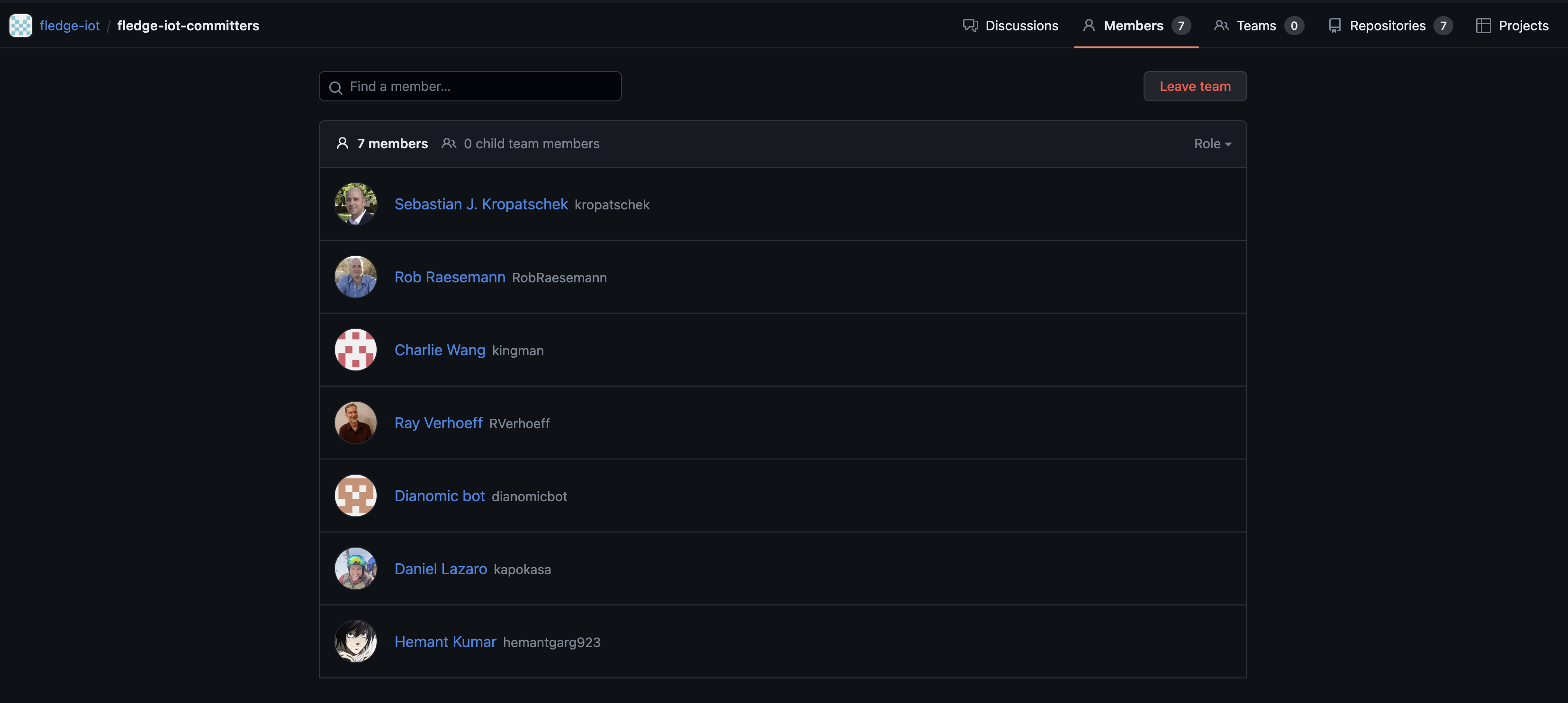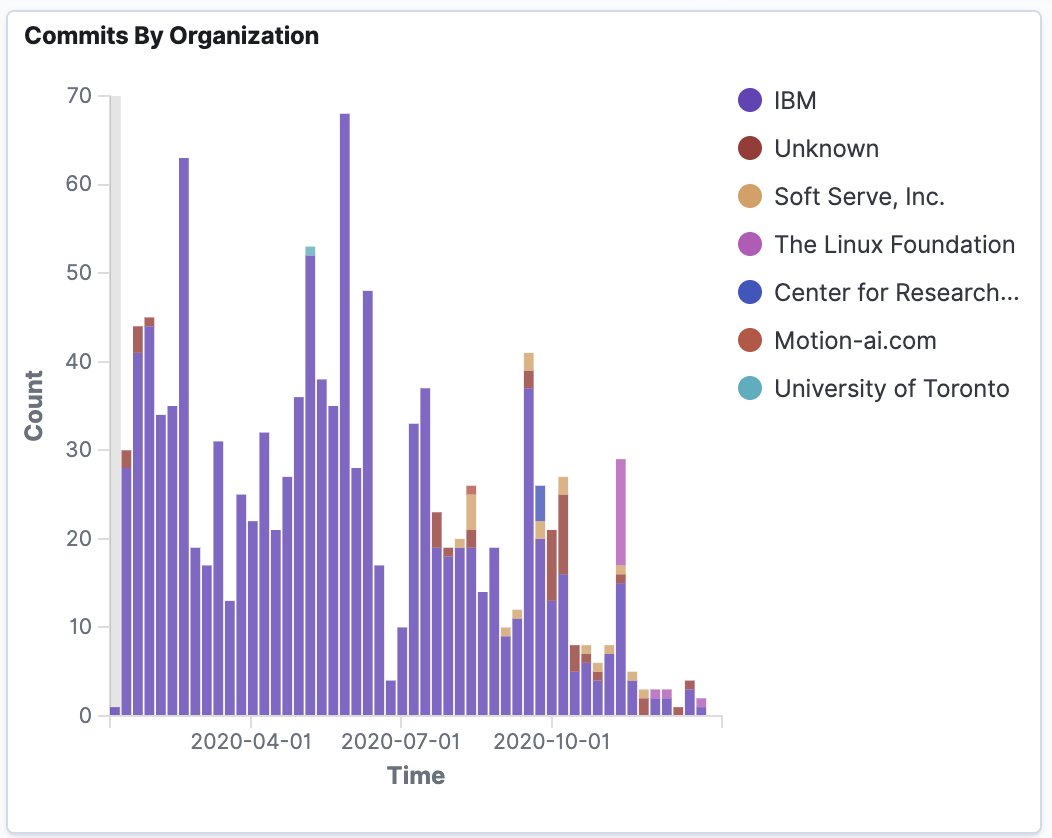...
Status
- Presented to the TAC: March 22, 2023
- TAC Project Review:
- TAC Vote Approved: April 13, 2023
- Governing Board Vote Approved:
Project Resources
- Web site: https://www.lfedge.org/projects/fledge/
- Wiki: Fledge Home
- Analytics: https://insights.lfx.linuxfoundation.org/projects/lfedge%2Ffledge/dashboard
- Communication & support: LF Edge Slack, automatic invite if you have no account there
- NOTE: Fledge’s official Slack channels are all prefixed with "fledge”
- Mailing Lists and Calendar: LF Edge groups: https://lists.lfedge.org/groups
- Fledge: https://lists.lfedge.org/g/fledge
- Fledge TSC:https://lists.lfedge.org/g/fledge-tsc
- YouTube playlist: https://www.youtube.com/playlist?list=PLgohd895XSUeQyifp-kq_xEUqGFLCFGgJ
- Mentorship Program:
...
Stage
...
3:
...
Impact Stage
Definition
The Impact Stage is for projects that have reached their growth goals and are now on a self-sustaining cycle of development, maintenance, and long-term support. Impact Stage projects are widely used in production environments and have largewith a significant number of public use cases. Moreover they have broad, well-established project communities with a number of contributors from at least two organizations.
...
diverse contributors.
Expectations
Are used in production environments.
Impact Stage projects are expected to participate actively in TAC proceedings, and as such have a binding vote on TAC matters requiring a formal vote, such as the election of a TAC Chair.
Projects that have publicly documented release cycles
...
.
Projects that are able to attract a
...
number of committers on the basis of its
...
production usefulness.
...
Projects that have several, publicly known, end-user deployments.
Expectations
Benefits
Impact Stage projects are expected to participate actively in TAC proceedings, and as such have a binding vote on TAC matters requiring a formal vote, such as the election of a TAC Chair. They receive ongoing financial and marketing support from the Foundation, and are expected to cross promote the foundation along with their activities.
- Annual discretionary budget
Acceptance Criteria
To graduate from At Large or Growth status , or for a new project to join as an Impact project, a project must meet the Growth stage criteria plus Impact stage criteria:
Stage 2: Growth requirements:
Demonstrate regular project leadership (typically TSC) meetings. Project leadership should meet monthly at a minimum unless there are extenuating circumstances (ex: holiday period).
Development of a growth plan (to include both roadmap of projected feature sets as well as overall community growth/project maturity), to be done in conjunction with their project mentor(s) at the TAC.
Document that it is being used in POCs.
Demonstrate a substantial ongoing flow of commits and merged contributions.
Demonstrate that the current level of community participation is sufficient to meet
thethe goals outlined in the growth plan.
Demonstrate
evidence of, or a plan for,a willingness to work with (via interoperability, compatibility or extension
to) other LF Edge
Projects. Examples may include demonstrating modularity (ability to swap in components between projects).Since these metrics can vary significantly depending on the type, scope and size of a project, the TAC has final judgement over the level of activity that is adequate to meet these criteriaprojects to provide a greater edge solution than what can be done by the project alone.
Onboard all project repositories with LFX Security. Working toward or achieving OpenSSF badging would be a plus.
Receive a two-thirds vote of all
TAC representativesTAC representatives that do not abstain the vote and a majority vote of the Governing Board to move to Growth Stage.
Stage 3: Impact requirements:
Have a defined governing body of at least 5 or more members (owners and core maintainers)
, of which no more than 1/3 is affiliated with the same employer.
In the case there are 5 governing members, 2 may be from the same employer.Have a documented and publicly accessible description of the project's governance, decision-making, and release processes.
Have a healthy number of committers from at least two organizations. A committer is defined as someone with the commit bit; i.e., someone who can accept contributions to some or all of the project.
Establish a security and vulnerability process which at a minimum includes meeting ("Met" or "?") all OpenSSF best practices security questions and SECURITY.md.
Demonstrate evidence of interoperability, compatibility or extension to other LF Edge Projects.
ExamplesExamples may include demonstrating modularity (ability to swap in components between projects).
Adopt the Foundation Code of Conduct.
Explicitly define a project governance and committer process. This is preferably laid
outout in
a filefile and references
a andand OWNERS.md
filefile showing the current and emeritus committers.
Have a public list of project adopters for at least the primary repo (e.g.,
oror logos on the project website).
- Other metrics as defined by the applying Project during the application process in cooperation with the TAC.
Receive a two-thirds vote of all
TAC representativesTAC representatives that do not abstain the vote and a majority vote of the Governing Board to move to Impact stage. Projects can move directly from At Large to Impact, if they can demonstrate sufficient maturity and have met all requirements.
Compliance with Requirements
...
Stage 2: Growth
| Requirement | Evidence |
|---|---|
| Two TAC sponsors | Joe Pearson (IBM), Jim St. Leger (Intel), Anil Vishnoi (Red Hat), Henry Lau (EdgeX Foundry) |
| Presentation to the TAC | Original presentation deck and recording from March 11, 2020 |
| IP Policy: licenses for code and documentation, DCO for contributions |
|
| List project (Stage One) status on web site or README | Updated LF Edge project page to reference (thanks, Brett!) |
| >= 2/3 approval vote of TAC & majority of Governing Board SPC |
|
Growth
| Demonstrate regular project leadership | Technical Steering Committee (TSC) |
| Growth plan | The Fledge project and community plans to create a strong ecosystem around Fledge to attract more users and stimulate community growth by:
The Fledge community has been growing steadily over the years incorporating a diverse set on contributors from various organizations.
The Fledge community has identified additional organizations focused on Industrial IIoT standards and systems. We intend to grow the Fledge community by engaging all 4 in PoCs, edge strategies and edge contributions. The four organizations are LF Energy, OSDU, CESMII and the Eclipse Foundation.
See more under Growth Plan, Roadmaps |
| Used in PoCs | Several public Use Cases cases have been documented and implemented on PoCs. New ones include:
For further info: Use Cases |
| Substantial ongoing commits and contributions | |
| Community participation meets growth plan goals | Several industrial communities in energy verticals have been the main focus but not limited to:
More information on past and ongoing collaboration can be found here: Cross-LF Edge Collaboration, Fledge Roadmap 2020/2021 and Fledge Home. AchievementsFledgePOWERFledgePOWER is a multi-protocol translation gateway for power systems based on the industrial IoT LF Edge project. This cross foundation collaboration between LF Edge and LF Energy ensures strong cooperative governance and technical alignment between the two communities. FledgePOWER aims to build and grow a community of end-users, developers, utilities, and other players to collaborate to solve current and future challenges in the energy space. Further information can be found on FledgePOWER Wiki and Demo OSDU EdgeOSDU has selected Fledge and EVE as the edge stack architecture for OSDU Edge. Meeting OSDU Edge requirements with LF Edge projects mitigating lock-in through vendor-neutral governance and interoperable solutions. Fledge is now in the OSDU Edge Lab. The architecture was successfully demoed to OSDU members in October, 2021. See more under Growth Plan,Roadmaps |
| Evidence of interoperability, compatibility with other LF Edge projects | The latest Fledge collaboration includes:
More information on past and ongoing collaboration can be found here: Cross-LF Edge Collaboration, Fledge Roadmap 2020/2021 and Fledge Home. |
| Onboard all project repositories with LFX Security | LFX Security Fledge |
Stage 3: Impact
| Requirement | Evidence | |
|---|---|---|
| Have a defined governing body of at least 5 or more members (owners and core maintainers) | The Technical Steering Committee (TSC) has expanded its voting members to 6 as follows:
| |
| Documented governance, decision-making, release processes | Fledge is an independent open-source project and not controlled by any single company. To emphasize this Fledge is governed under the Linux Foundation Edge and has graduated through the different Project Stages: Definitions and Expectations. Fledge is currently a Stage 2 project under this framework. For more information go to the Governance section. The following documented processes are in place: | |
| Healthy number of committers from at least two orgs (A committer is defined as someone with the commit bit; i.e., someone who can accept contributions to some or all of the project) | ||
| Establish a security and vulnerability process which at a minimum includes meeting | ||
| Requirement | Evidence | |
| Used in PoCs |
| |
| Substantial ongoing commits and contributions | Chart from https://tinyurl.com/yykvcfg5 showing commits over the last year. Notice that the diversity of organizations making commits increased quite a bit beginning in the July timeframe, two months after we officially became an LF Edge project. Attached are a few slides showing highlights of 2020 project stats. | |
| Growth plan | Growth plan for 2021:
| |
| Community participation meets growth plan goals | Growth plan for 2020: Met Partially Met: Created two SIGs (Manufacturing and Smart Agriculture), and the Open Retail Reference Architecture (ORRA) sub-project Ongoing: Arnaud Le Hors has volunteered to help lead this effort, will begin with standards around ORRA Missed: 8 new contributors, not 20 Met: Foxconn Industrial Internet and SoftServe In Progress Ongoing | |
| Evidence of interoperability, compatibility with other LF Edge projects | The latest Fledge collaboration includes: | and SDO hosted a
More information on past and ongoing collaboration can be found here: Cross-LF Edge Collaboration, Fledge Roadmap 2020/2021 and Fledge Home |
| Adopt LF Code of conduct | The Fledge community adheres to the LF Code of Conduct as described here: Code of Conduct | |
| Explicitly define a project governance and committer process | The Fledge community has defined and documented the following Repository Approval Policy as well as the committer process here: CONTRIBUTING.md and project Governance. | |
| Public list of project adopters | The Fledge Community welcomes contributions of all types; documentation, code changes, new plugins, scripts, just simply reports of the way you use Fledge or suggestions of features you would like to see within Fledge. A public list of project adopters can be found in ADOPTERS.md | joint demo at ONES-NA last September. Open Horizon integrates SDO rendezvous services into the management hub and CLI since SDO 1.8, and is continually upgrading that support as new SDO releases come out. Open Horizon now supports SDO 1.10. Open Horizon also has a technical and project liaisons to the SDO project.|
| >= 2/3 approval vote of TAC & majority of Governing Board |
...

